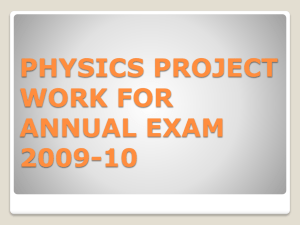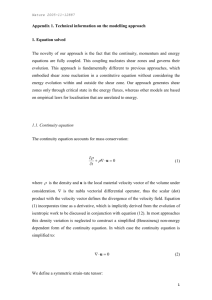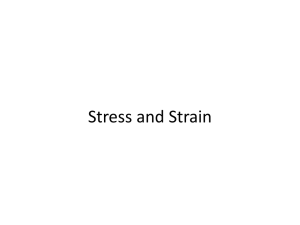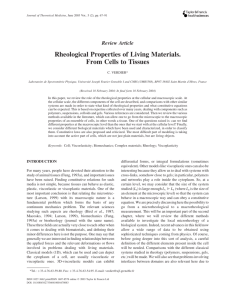Example
advertisement
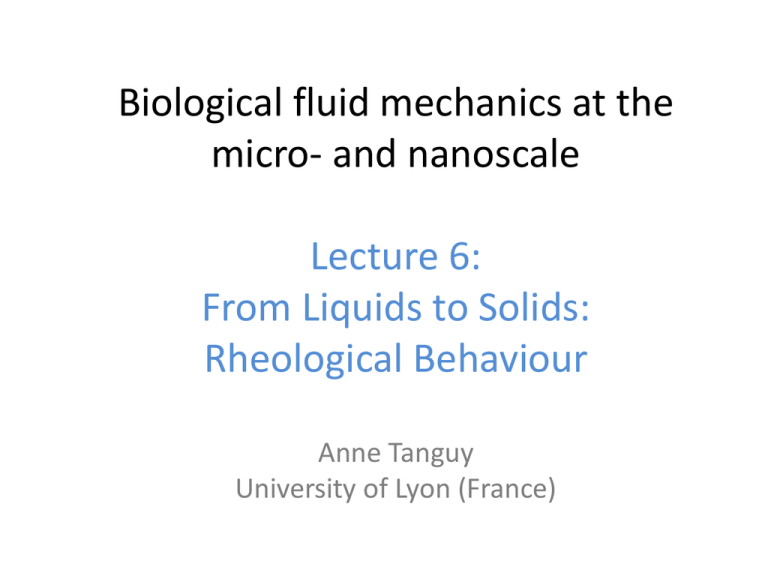
Biological fluid mechanics at the
micro‐ and nanoscale
Lecture 6:
From Liquids to Solids:
Rheological Behaviour
Anne Tanguy
University of Lyon (France)
From Liquids to Solids:
Rheological behaviour
I. Elastic Solid
II. Plastic Flow
III. Visco-elasticity
IV. Non-Linear rheology
Al polycristal
(Electron Back Scattering Diffraction)
Dendritic growth in Al:
Cu polycristal : cold lamination (70%)/ annealing.
TiO2 metallic foams, prepared with
different aging, and different tensioactif agent:
Si3N4
SiC dense
What is a « continuous » medium?
1) Two close elements evolve in a similar way.
2) In particular: conservation of proximity.
« Field » = physical quantity averaged
over a volume element.
= continuous function of space.
3) Hypothesis in practice, to be checked.
At this scale, forces are short range (surface forces between volume elements)
In general, it is valid at scales >> characteristic scale in the microstructure.
Examples: crystals
d >> interatomic distance (~ Å )
polycrystals
d >> grain size (~nm ~mm)
regular packing of grains d >> grain size (~ mm)
liquids
d >> mean free path
disordered materials d >> 100 interatomic distances (~10nm)
I. Elastic Moduli
REMINDER:
The Navier-Stokes equation:
with for a « Newtonian fluid »
2
3
P I 2h e ( h ).v I
wit h e v
Thus:
for an incompressible, Newtonian fluid.
(h dynamical viscosity)
S
The case of an Elastic Solid:
No transport of matter, displacement field u
d
S
S
Stress is related to the Strain u wit h e v
Hooke’s Law: ij
ij0 Cijkl. kl
dt
(anisotropy) 21 Elastic Moduli Cijlk in a 3D solid.
k ,l
Thus:
2 u
2 r .(C ( x, y, z ):S u) f
t
for a Linear Elastic Solid
(1635-1703)
1678: Robert Hooke develops his
“True Theory of Elasticity”
Ut tensio, sic vis (ceiii nosstuv)
“The power of any spring is in the same
proportion with the tension thereof.”
Hooke’s Law: τ = G γ or (Stress = G x Strain)
where G is the RIGIDITY MODULUS
Example of an homogeneous and isotropic medium:
stress componentsσ ij ij0 2m. ij .tr . ij
equationsof motion:
2u
2 2m .(.u ) m. ( u ) f ext
t
1 V 3 tr
1
compressibility
V P
tr
2m / 3
2 Elastic Moduli (,m)
u
F
Traction:
F
u
E.
S
L
v
u
.
L
L
E, Young modulus
, Poisson ratio
Simple Shear:
u
Hydrostatic compression:
P
F
u
m.
S
L
m, shear modulus
3
3(1 2 )
3 2m
E
, compressibility.
Sound waves in an isotropic medium:
2 sound wave velocities cL and cT
Onde longitudinale:
..
cL 2 . 2 , cL
2m
2
2
lmn c L .
cL .
. n2 m 2 l 2
L
Onde longitudinale:
Le mouvement des atomes
est dans le sens de la propagation
Ondes transverses: simple shear
m
cT . , cT
cL
..
2
2
Onde transverse:
Le mouvement des atomes
est perpendiculaire au sens de la propagation
Examples of anisotropic materials (crystals):
Ex. cobalt Co: HC FCC T=450°C
The number of Elastic Moduli
depends on the Symetry
FCC
3 moduli
C11 C12 C44
HCP
5 moduli
C11 C12 C13 C33 C44 C66=(C11-C12)/2
3 moduli
(3 equivalent axis)
6 (5) moduli
(rotational invariance around an axis)
Voigt notation:
C C
( )
C C
( )
C C
(
E
)
(11) 1
( 22) 2
(33) 3
( 23) 4
(31) 5
(12) 6
21 independent Elastic Moduli
Microscopic expression for the local
Elastic Moduli:
Simple example of a cubic crystal.
On each bond:
dEij
d2Eij
1
2
r0 (rij r0 ) . 2 r0 ...
Eij rij Eij r0 (rij r0 ).
dr
2
dr
strain
stress
Elastic Modulus
rij r0
r0
d2Eij r0
(rij r0 ).
2
4 fij
d
r
'11
2
4 r0 2
r0
11
2
1 d E ij r0 E ij r0
C11 '11 / 11 .
3
r0
dr 2
r0
General case: Local Elastic Moduli at small strain
1
C (i)
Vi
E ri1i2
.
( i1i2i3i4 ) ri1i2 ri3i4
2
C1 ~ 2 m 1
eq,
.ri1i2
eq,
eq
.ri3i4
ri1i2 .ri3i4
C2 ~ 2 m 2
eq,
eq
.ri3i4
eq,
.n(i1i2i3i4 )
i (i1i2i3i4 )
Born-Huang
C3 ~ 2 (+m
2D Lennard-Jones Glass N=216 225 L=483
Example of
an amorphous material
M. Tsamados et al. (2007)
Progressive convergence
to an isotropic material
at large scale
II. Plastic Flow
Plastic Flow:
S
F
u
Lz
In the Linear Elastic Regime:
F/S = E.u/Lz
Strain
Compressive
stress
Elastic modulus
Plastic Threshold y
.
Visco-plastic Flow flow
F/S
vitreloy
Plastic Flow
Elasticité+ Viscoelasticity
Elasticity
E
u/Lz
Rheological Description of the Plastic Flow:
.
Rheological law: shear stress , at a given P and T, as a function of shear strain, strain rate.
Creep experiment: at a constant , what is (t)?
Relaxation exp.:
at a constant , what is (t)?
(here: (t)=m. if Y /m and (t)=Y else)
Apparent viscosity: h(t,,d/dt) = (t,,d/dt) / (d/dt) (here: h=∞ if Y /m and h=0 else)
Here, no temporal dependence (≠ viscous flow)
Example: Flow due to an external force (cf. Poiseuille flow)
Binary Lennard-Jones Glass at T=0.2<Tg for tW=104 LJ
F. Varnik (2008)
Not a Poiseuille Flow
at small T
(Visco-Plastic)
≠Poiseuille
P
III. Visco-elasticity
Progressive flow of a solid
(1643-1727)
1687: Isaac Newton addresses liquids and steady
simple shearing flow in his “Principia”
“The resistance which arises from the lack of
slipperiness of the parts of the liquid, other things
being equal, is proportional to the velocity with
which the parts of the liquid are separated from
one another.”
Newton’s Law: τ = η dγ/dt
where η is the Coefficient of Viscosity Newtonian
Different behaviours:
Newtonian Viscous Fluid:
Ex. Water, honey..
h cste
0
d 1
1
. (t ) (t ) (t ' )dt .t
dt h
h0
h
t
Kelvin-Voigt Solid:
E V
d
(t ) m. (t ) h .
dt
m .t
0
h
(t ) . 1 e
m
Maxwell Fluid:
Delayed Elasticity (anelastic behaviour).
characteristic time t c
h
m
Ex. Solid close to Tf
Instantaneous Elasticity + Viscous Flow
E V
L2 kT
0 t
d 1 d 1
in crystals
. . (t ) (t ) . 0 , h
3
Da
dt m dt h
m h
General Linear Visco-Elastic Behaviour: (t ) f 0 . (t )
t .
f t t '. (t ' )dt'
0
(memoryeffect)
Dynamical Rheometers:
Oscillatory forcing:
0 sin(t )
Response:
0 sin(t )
G( ) G' ( ) iG' ' ( )
tan( ) G' ' / G' " internalfriction"
G' (). 0 .sin(t ) G' ' (). 0 . cos(t )
G’, Storage (Elastic) Modulus
Instantaneous response
Example of Perfect Elastic Solid:
G’’, Loss (Viscous) Modulus
Delay
G' m a nd G' ' 0
Example of Newtonian Viscous Fluid: G' 0 and G' ' h.
2 2
2
h
m
Example of Maxwell Fluid:G ' m.
and G ' ' h.. 2
m 2 2h 2
m 2h 2
0 : viscousresponseG' 0 and G' ' h.
: elasticresponseG' m and G' ' 0
Pastes
Energy Balance:
. 0
d
2
P .
.G ' ( ).sin(2t ) . 0 .G ' ' ( ).sin 2 (t )
dt
2
T /4
. 0 2
. 0 2
4
P (t )dt
.G ' ( )
.G ' ' ( )
T 0
2
2
Elastic Energy Stored during T/4
And then given back
(per unit volume and unit time).
Averaged Dissipated Energy
per unit time, during T/4,
due to viscous friction >0
G ' ' dissipatedenergy
tan
G'
storedenergy
Loss Factor (Internal Friction)
Loss factor
Material
> 100
Polymer or Elastomer (example : Butyl rubber)
10-1
Natural rubber, PVC with plasticizer, Dry Sand, Asphalte,
Cork, Composite material with sandwich structure (example
3 layers metal / polymer / metal)
10-2
Plexiglas, Wood, Concrete, Felt, Plaster, Brick
10-3
Steel, Iron, Lead, Copper, Mineral Glass
10-4
Aluminium, magnésium
Viscoelasticity of Polymers: General features
amorphous
crystalline
Storage Modulus
Internal Friction
Viscoelasticity of Polymers: Examples
Viscoelasticity of Mineral Glasses: Examples
SiO2 – Na2O
Si– Al-O-N
Lekki et al.
Viscoelasticity and crystallization
Polymer (PET)
Mineral Glass
ZrF4
Cristallization: G’ increases, mobility decreases
Frequency dependent behaviour
SiO2-Na20-Ca0
Example of Blood Red Cells:
(t)/0
G’
G’’
Macroscopic creep in Metals:
Creep
T>
Lead Romanian Pipe
Metals
0,3-0,4 Tm
Ceramics
0,4-0,5 Tm
Polymers
Tg
~ 1h
Dislocation creep: b=0 m=4-6
Nabarro-Herring creep: b=2 m=1
Non-Linear behaviour
0.3 Tm<T<0.7 Tm
Linear (Newtonian) flow
diffusion of defects
T>0.7 Tm
Metling Temperatures, for P=1 atm, Ice: Tm=273°K, Lead: Tm=600°K, Tungsten: Tm=3000°K
m
10-1
Theoretical Limit
Plasticity
10-2
Athermal Elastic Limit
10-3
Creep
Dislocation
Core
Volume
10-4
10-5 Elasticity
10-6
0
0,3
Creep
Diffusion
Grain
Volume
Boundaries
0,5
0,7
1
T
Tm
IV. Non-Linear Rheology
Pastes
Colloids
Powders
Metallic Glass
Mineral Glass (SiO2, a-Si) Polymers (PMMA,PC)
From the Liquid to the Amorphous Solid:
Non-Linear Rheological Behaviour
F. Varnik (2006) 3D Lenard-Jones Glass
Non-Linear Rheological Behaviours:
Shear softening
Ex. painting, shampoo
n
.
K . with n 1 Ostwald (1925)
Shear thickening
Ex. wet sand, polymeric oil,
silly-putty
n
.
K . with n 1
Plastic Fluid
Ex. amorphous solids, pastes
.
C 0
n
.
C C K .
Bingham n 1, Herschel- Bulkley n 1, Casson
Example:
in amorphous systems (glasses, colloids..)
Ex. Beads made of polyelectric gel
with <1
Ex. Lennard-Jones Glass
Tsamados, 2010
.
xy / h
.
shear softening
Simulations of Rheological Behaviour
at constant Strain Rate and Temperature
in an amorphous glassy material (Lennard-Jones Glass)
Low strain rate
Progressive Diffusion of Local Rearrangements
Finite Size Effects
Large strain rate
Nucleation of Local Rearrangements
M. Tsamados 2010
Density of nucleating
centers per unit strain
Diffusion of plasticity
Cooperativity Maximum
when L1=L2
h
?
m
Lecture 7
Atomistic Modelling:
Classical Molecular Dynamics Simulations
for fluid dynamics.
I. Description
II. The example of Wetting
III. The example of Shear Deformation
Classical Molecular Dynamics Simulations consists in solving the Newton’s equations
for an assembly of particles interacting through an empirical potentiaL;
In the Microcanonical Ensemble (Isolated system): Total energy E=cst
In the Canonical Ensemble: Temperature T=cst
with
if no external force
Different possible thermostats: Rescaling of velocities, Langevin-Andersen, Nosé-Hoover…
more or less compatible with ensemble averages of statistical mechanics.
Equations of motion: the example of Verlet’s algorithm.
Adapt the equations of motion, to the chosen Thermostat for cst T.
Thermostats:
after substracted the Center of Mass velocity, or the Average Velocity along Layers
dv
• Langevin Thermostat: mi i G.vi Fi k (t )
dt
Random force k(t)
Friction force –G.v(t)
with <k(t).k(t’)>=cste.2GkBT.(t-t’)
• Andersen Thermostat: prob. of collision t, Maxwell-Boltzman velocity distr.
• Nosé-Hoover Thermostat:
dH
0
dt '
• Rescaling of velocities:
• Berendsen Thermostat:
with
(
)1/2
Heat transfer. Coupling to a heat bath.
Examples of Empirical Interactions:
The Lennard-Jones Potential:
2-body interactions
cf. van der Waals
Length scales ij ≈ 10 Å
Masses mi≈10-25 kg
Energy ij≈ 1 eV ≈ 2.10-19J ≈ kBTm
Time scale
Time step t = 0.01 ≈ 10-14 s
106 MD steps ≈ 10-8 s = 10 ns
or
m. 2
0.1 2
1020
8 1012 s
10 s or
D(T 1) 10
12
106x10-4=100% shear strain in quasi-static simulations
N=106 particles, Box size L=100 ≈ 0.1 mm for a mass density =1.
3.N.Nneig≈108 operations at each « time » step.
The Stillinger-Weber Potential:
For « Silicon » Si, with 3-body interactions
Stillinger-Weber Potential F. Stillinger and T. A. Weber, Phys. Rev. B 31 (1985)
4
ESW (1,2,...,N ) i , j ( A.r B ). e
Melting T
Vibration modes
Structure Factor
( r a ) 1
2-body interactions
(Cauchy Model)
.(rij a ) 1 .(rik a ) 1
i , j ,k f (ijk ). e
3-body interactions
The BKS Potential:
For Silica SiO2, with long range effective Coulombian Interactions
B.W.H. Van Beest, G.J. Kramer and R.A. Van Santen, Phys. Rev. Lett. 64 (1990)
EBKS (r )
qi q j
4 0 r
Aij e
Bij r
Cij
r
6
où(i, j ) Si,O
Ewald Summation of the long-range interactions,
or Additional Screening (Kerrache 2005, Carré 2008)
Example: Melting of a Stillinger-Weber glass, from T=0 to T=2.
Microscopic determination of different physical quantities:
-Density profile, pair distribution function
-Velocity profile
-Diffusion constant
-Stress tensor (Irwin-Kirkwood, Goldenberg-Goldhirsch)
-Shear viscosity
(Kubo)
II. The example of Wetting
Surface Tension: coexistence beween the liquid and the gas at a given V.
Surface Tension:
h
The Molecular Theory of Capillarity:
Intermolecular potential energy u(r).
Total force of attraction per unit area:
Fz h 1. 2 dz d 3r. f z r
h
21. 2 r (r h)u (r )dr
h
Work done to separate the surfaces:
h0
h0
W 2 S Fz h dh 1. 2 dr .r 3 .u (r )
(I. Israelachvili, J.S.Rowlinson and B.Widom)
3
LV . cos SV SL for SV SL LV .
III. The example of Shear Deformation
Boundary conditions:
Example: quasi-static deformation of a solid material at T=0°K
Quasi-static shear
at T=0.
Fixed walls
Or biperiodic boundary conditions
(Lees-Edwards)
At each step, apply a small strain ≈ 10-4 on the boundary,
And Relax the system to a local minimum of the Total Potential Energy V({ri}).
Dissipation is assumed to be total during .
t a / c 1012 s
Quasi-Static Limit
.c
lim.c
108 s 1 ( 10 4 u LJ ).
t
a
a
ux
F
xy shear stress
S
Ly
st rain xy
Rheological behaviour:
Stress-Strain curve in the quasi-static regime
ux
2 Ly
F
xy shear stress
S
ux
Ly
st rain xy
ux
2 Ly
y
Local Dynamics:
Global and Fluctuating Motion of Particles
X
F
xy shear stress
S
ux
Ly
Local Dynamics:
Global and Fluctuating Motion of Particles
Transition from Driven to Diffusive motion
due to Plasticity, at zero temperature.
y _ max
st rain xy
cage effect
(driven
motion)
ux
2 Ly
p
Diffusive
n ~ xy
Tanguy et al. (2006)
Low Temperature Simulations: Athermal Limit
.
Typical Relative displacement due to the external strain
Typical vibration of the atom due to thermal activation
>>
larger than
a. .t
k BT
kh
Convergence to the quasi-static behaviour, in the athermal limit:
At T=10-8 (rescaling of the transverse velocity vy et each step)
M. Tsamados
(2010)
.
h .
.
.
0 .4
h . cste
at finite T
Effect of aging
T= 0.2-0.5 Tg =0.435
Rescaling of transverse velocities in parallel layers
Non-uniform Temperature Profile at Large Shear Rate
Time needed to dissipate heat created by applied shear across the whole system
c 1 m
td
L L
.
dQ
xy .
Heat creation rate due to plastic deformation
dt
tQ
Time needed to generate kBT,
.
tQ t d
k BT
.
xy .
k BT .L
.
c. xy
Visco-Plastic Behaviour:
Non uniform T
Flow due to an external force (cf. Poiseuille flow)
F. Varnik (2008)
The relative importance of Driving and of Temperature must be chosen carefully.
See you in Lyon!


